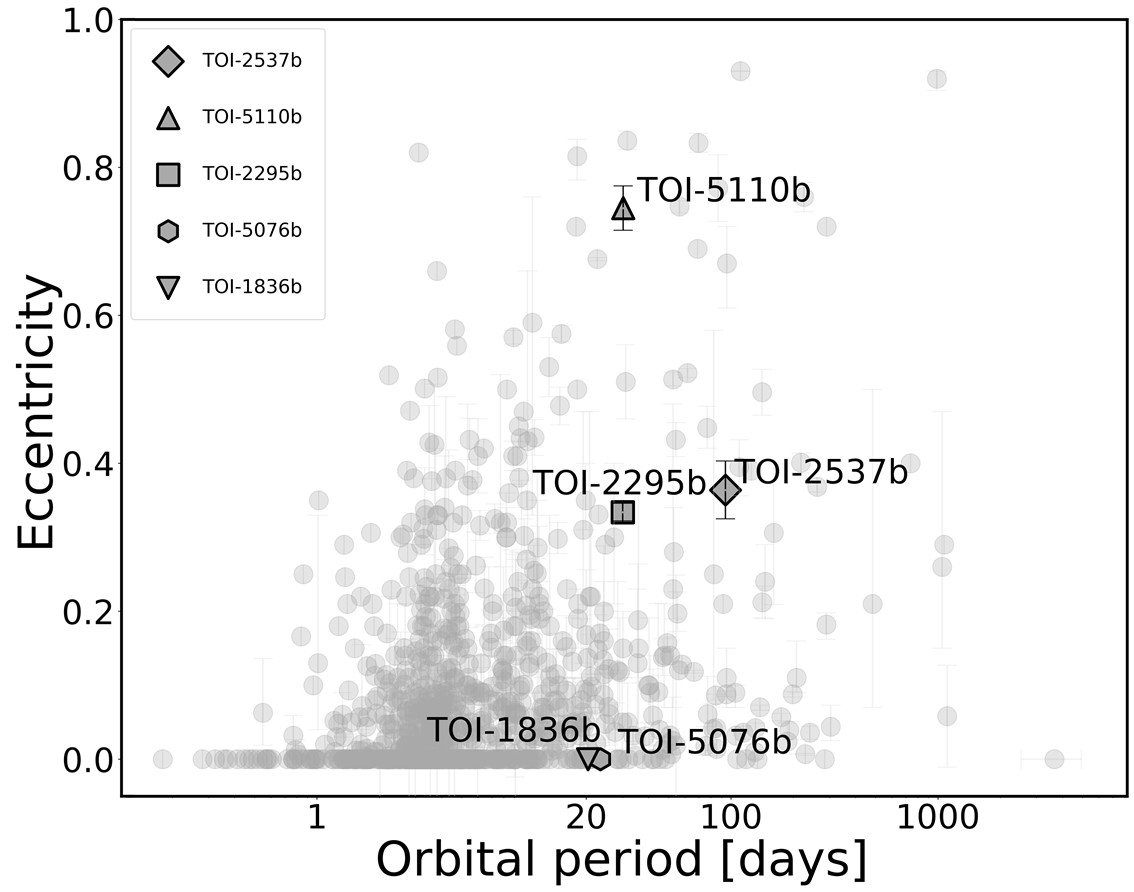DISCOVERY AND CHARACTERIZATION OF THREE WARM JUPITERS FROM SOPHIE AND TESS
While thousands of exoplanets have been confirmed, the number of warm Jupiters in transit remains relatively small, despite their key role in planetary science. An international team, led by a young researcher from the Institut d’astrophysique de Paris, announces the discovery of three new warm Jupiters. Notably, TOI-5110b stands out due to its very elliptical orbit, making it one of the most eccentric known planets, while TOI-2537b shows variations in transit time, suggesting gravitational interactions with a second companion.
Since the discovery of the first planet orbiting a star other than our Sun in 1995, over 5,000 exoplanets have been identified. Among them, transiting warm Jupiters are key targets for studying planetary formation and evolution. These gas giants, similar in size and mass to Jupiter, orbit their stars at moderate distances, with orbital periods ranging from 0.3 to 7 months. Their moderate distance from the star minimizes the effects of stellar proximity, preserving clues of their formation and evolutionary history. Despite their importance, the discovery and characterization of warm Jupiters, particularly those with longer orbital periods (>20 days), remain limited. These planets account for only about 2% of all discovered exoplanets.

Figure 1: The SOPHIE spectrograph, installed at the Haute-Provence Observatory. This instrument was used for the discovery and characterization of the planets presented in this study.
Credit: OSU Pytheas, CNRS, AMU.
The Exoplanet team at the Institut d’astrophysique de Paris (IAP), in collaboration with an international network of researchers, has discovered three new warm Jupiters—TOI-2295b, TOI-2537b, and TOI-5110b—with orbital periods ranging from 30 to 94 days. These discoveries, led by Neda Heidari, a postdoctoral researcher at IAP, were made using data from the high-precision SOPHIE spectrograph at the Haute-Provence Observatory in France (see figure 1), alongside NASA’s Transiting Exoplanet Survey Satellite (TESS) and the European Space Agency’s CHEOPS (CHaracterising ExOPlanet Satellite) space telescope.
TESS and CHEOPS use the transit method, observing planets as they pass in front of their host stars, causing a temporary dip in brightness. Data from these transits enabled the team to estimate the planets' diameters, ranging from 1.0 to 1.5 times that of Jupiter. The SOPHIE instrument uses the radial velocity method, detecting tiny variations in a star’s motion caused by the gravitational pull of orbiting planets. This allowed the team to measure the planets’ masses, ranging from 0.9 to 2.9 times that of Jupiter. Additionally, the SOPHIE data revealed that TOI-2295b and TOI-2537b are part of multi-planet systems. Their outer companions—TOI-2295c and TOI-2537c—have orbital periods of 2.6 and 5.3 years, respectively, and masses of at least 6 and 7 times that of Jupiter.
Among these planets, TOI-5110b stands out due to its highly elliptical orbit with eccentricity of 0.7, making it one of the most eccentric planets discovered to date (see figure 2). This extreme eccentricity may be explained by the planet interacting with another body in the system, causing its orbit to shrink and become more eccentric. If this is the case, TOI-5110b could be a “proto-hot Jupiter”—a giant planet that formed in a distant orbit, migrated inward, and is still moving closer to its star. Eventually, it could become a hot Jupiter with an orbit of less than 10 days. Although this scenario is plausible, current data show no evidence of another planet in the system driving this migration. Further observations will be crucial to uncover the dynamics of this system.

Figure 2: Eccentricity-period diagram of the transiting planets in this study, together with other exoplanets with known characteristics (NASA data as of February 26, 2024). TOI-5110b stands out as one of the most eccentric planets discovered to date.
Credit: Neda Heidari.
The team also discovered that the timing of TOI-2537b's transits varies by about 22 minutes, while most planets detected so far have transit timings precise to within seconds. This phenomenon, known as transit timing variations (TTVs), suggests that the planet does not follow a Keplerian orbit. The team proposes that these variations are most likely caused by the gravitational influence of the outer planet in the system, TOI-2537c, which orbits farther out. To fully understand the dynamics of this system, additional transit observations will be essential. These observations will refine our models and provide a clearer picture of the planets' interactions and the system's overall evolution.
Links
![]() The scientific article published today in the journal Astronomy & Astrophysics by Heidari, Hébrard, Martioli, Eastman et al. (2025), “Characterization of seven transiting systems including four warm Jupiters from SOPHIE and TESS”
The scientific article published today in the journal Astronomy & Astrophysics by Heidari, Hébrard, Martioli, Eastman et al. (2025), “Characterization of seven transiting systems including four warm Jupiters from SOPHIE and TESS”
![]() The SOPHIE spectrograph at OHP
The SOPHIE spectrograph at OHP
Writing and contact
- Neda Heidari
CNES postdoctoral felow, Institut d’astrophysique de Paris, CNRS, Sorbonne Université
neda [dot] heidari [at] iap [dot] fr - Guillaume Hébrard
Institut d’astrophysique de Paris, CNRS, Sorbonne Université
guillaume [dot] hebrard [at] iap [dot] fr
Layout: Jean Mouette
February 2025
